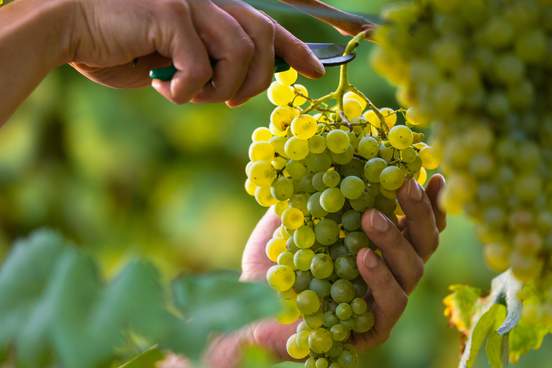
Wine
People have been making wine for around six thousand years—it’s nearly twice as old as beer. The word wine is also old, one of the small number of Latin-based words already present in Old English. It likely came over with the Germanic-speaking Angles, Saxons, and Jutes in the 5th century, after the departure of the occupying Romans. The oldest words of Latin origin had already become part of the proto-English spoken by these tribes before they left the continent, including street, cheese, mile, crown, and wine, as well as some words connected to the spread of Christianity, like priest, church, devil, angel, and mass.
Just like wine is the product of the fruit of the vine, the word wine is derived from the Latin word vinum, which makes it the origin of both our words wine and vine, one of those etymological twinships that is hiding in plain sight.

Oenophile
Wine might come from a Latin word, but the term meaning “a lover or connoisseur of wine,” oenophile, pronounced /EE-nuh-file/, comes instead from the Greek word for wine, oinos. This is probably because of the pattern of using the productive Greek combining form -phile to mean “lover” or “one having an affinity or a strong attraction to,” a pattern that includes words like bibliophile or audiophile or Francophile.

Sommelier
The proper name for a wine steward (or wine specialist or wine waiter) at a fancy restaurant is sommelier, pronounced /somm-ehl-YAY/. It comes from the word meaning “pack,” as in the heavy bags or luggage that would be carried or pulled by horses; the French term bête de somme means “pack animal.” This presumably meant that at some point in the past, the person in charge of the supplies was the person who also served the wine or at least knew the most about it.
Informally, and especially in the restaurant and hospitality industry, a sommelier is sometimes called a somm. Passing the exam to become a Master of Wine—a high-level rank for a wine expert, many of whom work as sommeliers—is a famously difficult achievement, and a well-known documentary film about young wine experts is called Somm.
Although sommelier is a fairly recent borrowing from French, dating from the late 1800s, an earlier form of the word, somler is listed in the Oxford English Dictionary as having been used in English from the 1500s, with the meaning “butler.” Butler, it turns out, has a parallel history, since it comes from the word bottle, a name for the person who oversees the storage of wine and serves it from bottles.

Terroir
You sometimes hear the expression “wine is food” from wine makers and wine lovers. And visiting a vineyard is very much like visiting a farm; the grapes that are grown become the wine that you drink, and wine changes as it ages in the bottle—it can go bad if it’s exposed to too much heat or left for too long, like all food.
A recent addition to our dictionary is terroir which means “the combination of factors including soil, climate, and sunlight that gives wine grapes their distinctive character.” Wine takes on the traits of the grapes, but also the soil and weather and even the amount of rain that fell in a certain year (which is why we call those years vintages).
The taste, quality, and identity of any given wine, in other words, goes beyond which variety of grapes were used to make it. Many of the other essential, natural elements about a particular wine can be collectively referred to as its terroir, from the French word meaning “earth” or “land.” Notice that terroir has other Latin-based cousins in English, from territory to terrestrial.

Vintage
Vintage is another wine word with its roots hiding in plain sight. Or maybe we should say its “vines” hiding in plain sight, since the vin in vintage comes from the same Latin word that gave us both vine and wine. Although vintage today is often used to mean “old” or “classic,” its original meaning was “a season's yield of grapes or wine from a vineyard,” and especially “a usually superior wine all or most of which comes from a single year.” This is where the expression “a very good year” comes from.
But the French word essentially just meant “harvest,” and came from word roots that literally meant “to take off the vine.” There is a rare English word that uses an older form of vendenge, vendage that shares this “harvest” meaning.
The place where a planting of grapevines is located is called a vineyard, literally a “yard of vines.”

Varietal
Different grapes make different wines. While it’s true that there are big categories like red wine and white wine, as well as rosé and even orange wine, the choice of grapes to make any given wine are the stars of the show; they determine much of a wine’s character, color, texture, and taste.
Because there are different varieties of grapes, just as there are different kinds of apples, the names of these grapes become familiar when they are used to make wine. The term used for the grape that makes a particular wine is varietal.
Sometimes wines are referred to by the names of the grapes that are used to make them. Some prominent examples of varietals include:
Reds:
grenache (also known as Garnacha)
Malbec (also known as Côt)
Whites:
Pinot Grigio (also known as Pinot Gris)
Semillon
Viognier

Appellation
Appellation is the French word for “name” or “designation.” French has been the source of many of our words connected with wine, including vine, terroir, sommelier, and vintage, but it’s a simple fact that many English words have French origins, whether they describe vinification or not. Since a major source of English words is also a major source of wine culture, there’s nothing surprising about any of this.
The French have also contributed their ideas about the importance of identifying wines by where they come from as opposed to what grapes are used to make them. The French legal system of Appellation d’Origine Contrôlée or AOC means both that places where wine is grown must conform to traditional winemaking methods, especially concerning which grape varieties can be used; for example, red wine made in Beaujolais must use only Gamay.
The French have also pioneered the protection of these identities, making the names of wines function a bit like trademarked brand names: unless the wine is made in Bordeaux or Burgundy or Champagne, it is illegal to market them with those regional names. The same goes for the next level of specificity, which is the name of famous winemaking villages, like Chablis or Châteauneuf-du-Pape.

Sparkling Wine
Wine that is effervescent—that is, wine that has bubbles—is called sparkling wine.
It’s a broad category that includes Champagne, which is made by adding a bit of yeast and sugar inside the bottle which encourages the formation of carbon dioxide during fermentation, resulting in bubbles. This is sometimes called the “traditional method” or the “Méthode Champenoise.” Another way to make sparkling wine is to add the yeast and sugar mixture to the whole tank of fermenting wine rather than to the individual bottles. This is the method used to make Prosecco and Lambrusco and many other types of sparkling wine.
A third way to make bubbles in wine is to chill the wine before transferring from vats or barrels to bottles, and then allow it to ferment without adding any extra sugar. This is sometimes called the “ancestral method,” because it’s thought to be the oldest way to make effervescent wine. The result is called pétillant naturel, from the French word for the crackling sound made by bubbles, derived ultimately from the French word meaning “to break wind.” We are inclined to believe that the wine tastes better than its etymology smells.

Magnum
Magnum is the Latin word meaning “large,” but since it’s used as a noun in English, perhaps “large thing” or “large one” is a better translation. Its connection to wine has to do with having a lot—or perhaps too much—of a good thing. In the early 1700s, magnum bonum (“a large good thing”) was a term used to mean “a large bottle of wine,” and subsequently the bonum dropped off, to make magnum the designation of a large bottle of wine, specifically one that contains 1.5 liters, or the equivalent of two standard bottles, usually of Champagne.
The bottle that is twice the size of a magnum is called a Jeroboam; one twice that size is called a Methuselah. The names of ever-larger bottles include Salmanazar (equivalent to twelve bottles), Balthazar (sixteen bottles), and Nebuchadnezzar (twenty bottles). These words come from the names of biblical kings and patriarchs, and form a kind of hierarchy of size, presumably for large celebrations.

Decanter
A decanter is a large vessel or pitcher, usually made of glass, into which wine is poured for serving. Its main purpose isn’t decorative, however: decanters usually allow for much more contact with oxygen than the narrow neck of a wine bottle permits. This exposure to air allows the wine to “breathe,” or to develop flavor and bouquet; it also gives the sommelier or host the chance to keep any sediment from the serving vessel.





